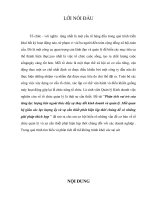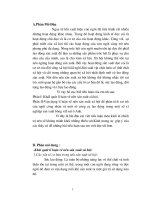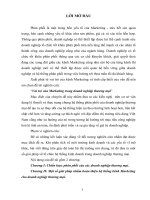Phân tích vài trò của CFO trong doanh nghiệp
Bạn đang xem bản rút gọn của tài liệu. Xem và tải ngay bản đầy đủ của tài liệu tại đây (72.14 KB, 15 trang )
Phân tích vài trò của CFO trong Doanh nghiệp
TABLE OF CONTENT
TABLE OF CONTENT................................................................................................2
RESEARCH OF CONTENT........................................................................................3
PART 1: FOREWORD..................................................................................................3
1. Role of corporate finance..........................................................................................3
2. Goal of corporate finance..........................................................................................4
3. Role of the CFO (chief financial officer) in the enterprise........................................5
4. The need of titles CFO (chief financial officer) in businesses of Vietnam................6
PART 2: TEST..............................................................................................................8
LIST OF REFERENCES............................................................................................16
1
RESEARCH OF CONTENT
PART 1: FOREWORD
1. Role of corporate finance
Enterprise is a business organized for the purpose of profit is recognized by
law, be allowed to do business on a certain number of areas, from one or more owners
and owners must ensure equal before the law the whole of his property, has its own
name, transaction-based stability.
In the market economy, the types of businesses to develop a diverse and
abundant. There are many approaches to business. If the angle at which demand and
supply in the economy, the business is divided into business currency finance business
and non-financial corporate business common goods and services. If the relationship
is based on ownership of the means of production, the enterprise is divided into stateowned enterprises, private enterprises and joint stock companies. If based on the legal
form of business organization, the small multi enterprises are divided into state-owned
enterprises, joint stock companies, limited liability companies, partnerships,
enterprises and foreign investment private enterprises.
Although the division does for a business when conducting business activities
are used to finance businesses to conduct business objectives. To conduct business
activities, enterprises need to have the necessary elements are documented labor,
objects of labor and labor power, which requires businesses to have a certain amount
of capital. To this must now form and use monetary funds. Business processes of the
enterprise as well as the process of formation, distribution and use of monetary funds
business. In the process, the arising and established cash flows associated with the
investment activities and operations of the business regularly.
The cash flows involve cash flows going into and the cash flow going out of
business, making the movement of the flow of corporate finance. Within the process
of creation, distribution and use of monetary funds of enterprises is the economic
relationship, the relationship is called the financial ties and relations including the
following:
2
- Financial relations between enterprises and other entities shown in the capital
contribution, loan, loans,etc,..., in payment for the purchase or sale of assets,
materials, goods and services,etc,...
- Financial relations between enterprises and workers in enterprises: salaries,
bonuses, penalties material.
- The relationship between the parts of the business as part payment between
enterprises and the distribution of profits after tax of enterprises, the formation and
use of corporate funds.
- Financial relations arising in the social activities of the enterprise as funding
for social organizations, charities, gymnastics, sports, culture,etc,...
- Financial relations between enterprises and foreign enterprises as joint
ventures with foreign companies operating in Vietnam, the export and import of goods
and services,etc,...
From the form of financial relationship can be concluded on corporate finance
in terms of physical content is the currency in the enterprise fund is created, used for
business purposes of the business, essentially in terms of the economic relations
between enterprises and the social economy actors in and outside the country.
2. Goal of corporate finance
Finance business is the distribution relationship in the form of values
associated with the creation and use of corporate funds in the currency trading
process. Financial analysis is the overall methods used to assess the financial situation
of the past and present, to help managers make the correct management decisions and
evaluating the activities of production business enterprises, thereby helping to objects
of interest to accurately predict the presence of corporate finance. Thereby, make
decisions consistent with the interests of those who are interested in the financial
situation of enterprises.
There are many objects of interest and use of economic information, financial
business. Each object is concerned perspective and different goals. As the demand for
financial information of diverse businesses, financial businesses require to be
analyzed into different segments with different methods from which to meet the needs
of the object of interest . This has facilitated the development of corporate finance.
Corporate Finance for managers to meet business objectives as follows:
3
- Create a regular cycle to assess the operational management during the period
was over, the implementation of fiscal balance, profitability, liquidity and business
risks,etc....
- How to decide the direction of the Director in accordance with the actual
situation of enterprises to make decisions about investment, funding, distribution of
profits,etc,...
- Analysis of corporate finance is the basis for predictions about the financial
situation of the enterprises in the future.
- Analysis of corporate finance is a tool to check and control of business
operations.
Thus, analysis of corporate finance is a useful tool to be used to determine the
economic value, to evaluate the strengths, the weaknesses of a business, find out the
cause and objective subjective, allowing managers to select and find the decision in
accordance with the actual situation of production and business activities of
enterprises.
3. Role of the CFO (chief financial officer) in the enterprise
I think the CFO has great value and indispensable role in our organization.
When matter what happens to the company, the CFO is "Whistleblowers" and make
note for the Board of Directors. Therefore, they require the CFO is truthful and
trustworthy, to have the technical skills, leadership skills and soft skills are also
important. The members of the Board of Directors thought that the good CFO who has
a deep understanding of the business activities of the company. He has worked in
other parts, in contact with the company's work and have skills in conducting the
business of the enterprise. CFO not only knows how to present the statistics, but also
to profoundly understand these numbers mean and how these parameters imply that
past actions are, based on the parameters that; understand the financial risks.
CFO has tremendous value, especially "CFO increasingly more important as
businesses have difficulty". The CFO also needs to have an intimate relationship with
the CEO and other partners, to support the CFO and the CEO share the same opinion.
Once incompatible CFO and CEO, will lead to a lot of controversy, and led to the
mess in company. However, if CFO too close to CEO will fall down "ones blown the
whistle" is affected, and the CFO will no longer be making decisions about financial
4
independence. It is best to keep the CFO position coordination center in the
assessment and management of risk, although not required CFO to be held and
understand all the risks.
Chief Financial Officer position is a director of corporate financial
management such as research, analysis, construction and financial plans; exploitation
and efficient use of funds, warned the risk to the business through financial analysis
and make reliable forecasts in the future. The role of the CFO is completely different
from accounting. Many of the tasks that the CFO chief accountant can not be done.
Enterprises wishing to be strong is not strong financially not so demanding CFO
position is very talented in the financial sector and to have vision better strategic
thinking, sensitivity investments of business.
4. The need of titles CFO (chief financial officer) in businesses of Vietnam.
At a macro perspective, vision and financial capacity of international
accounting Vietnam has made great progress compared to the past. However, the
activity level of the domestic financial system, as well as financial management
capacity of the Vietnamese people in general still exists a gap over the world really.
In business perspective, the important role of today's CFO is undeniable, even
for small and medium businesses. Even though a business development strategy is
good and successful business can still fall into financial difficulties and lead to
bankruptcy without a CFO makes good financial governance.
At the individual level, "portrait" of a professional CFO today has far different
than in the past. A CFO who is good at yesterday may not necessarily stand in the
position of CFO today, let alone success story.
Because, previously, in the context of an economy that was essentially "closed"
and our financial system is being developed at a very low level compared with the
world. Because, today, Vietnam has been one of deeper integration with the world in
all aspects, especially in this economic integration - financial. Because now, the
Vietnamese will have to compete with the world right in the "house" of her, including
the ability to compete on financial management. And people today do not only
financial resources compared to their peers in the country, but also to compete with
their peers around the world,etc,...
5
Want to effective business management, CEO (Chief Executive Officer) always
need the support of the V.I.P as CFO, CTO, CPO ... In particular, the CFO (Chief
Financial Officer) may be considered "V.I.P of V.I.P" because here is the realization
of the vision (vision) of CEOs in the financial sector - the most important factor to
evaluate the success of a business. Therefore, the CFO is not necessarily a close friend
of the CEO but certain people have the ability to coordinate food ideas with the CEO
and the CEO can put all beliefs. It is a prerequisite for sustainable business
development.
6
PART 2: TEST
Please choose the most correct answer by circling on the correct answer that you have
selected. Template questions have only one correct answer.
INFORMATION BELOW (TABLE 1) USED FOR ANSWERS FROM QUESTION 1
TO QUESTION 5
Balance Sheet of the Smith Company
Assets:
Cash and securities marketable
Receivables
Inventories
Prepaid expenses
Total Current Assets
Fixed assets
Except: accumulated depreciation
Net fixed assets
Total Assets
Liabilities:
Short-term payables
Negotiable instrument payables
Tax accrual
Total current liabilities
Long-term debt
Equity
Total Long-term debt and Equity
$300.000
2.215.000
1.837.500
24,000
$3.286.500
2.700.000
1.087.500
$1.612.500
$4.899.000
$240.000
825.000
42.500
$1.107.000
975.000
2.817.000
$4.899.000
7
Income Statement
Net sales (sell on credit)
Except: Cost of goods sold
Selling expenses & General administration expenses
Depreciation expense
Interest expense
Income before tax
Corporate income tax
Income (profit) net
Common stock dividends
Income (profit) leave
1. Based on the information in Table 1, the current rate is:
A.
2,97
B.
1,46.
C.
2,11.
D.
2,23.
$6.375.000
4.312.500
1.387.500
135.000
127.000
$412.500
225.000
$187.500
$97.500
$90.000
2. Based on the information in Table 1, using 360 days / year average collecting
money period:
A.
71 days
B.
84 days
C.
64 days
D.
125 days
3. Based on the information in Table 1, the debt ratio (ratio of liabilities) is:
A.
0,70.
B.
0,20.
C.
0,74.
D.
0,42.
4. Based on the information in Table 1, the net profit margin on sales equal how much:
A.
4,61%.
B.
2,94%.
C.
1,97%.
D.
5,33%.
5. Based on the information in Table 1, the Inventory Turnover Ratio is:
A.
0,29 times
B.
2,35 times
8
C.
0,43 times
D.
3,47 times
6. Which is type the following companiesno subjectload limited liability debt?
A)
Private Company
B)
Joint Stock Company
C)
Public company
D)
All the above answers are wrong
7. Calculate the present value (PV) of $ 100,000 received after 5 years from today,
assuming an interest rate of 8% / year?
A)
$60.000,00
B)
$68.058,32
C)
$73.502,99
D)
$82.609,42
8. Calculate the present value (PV) of $ 80,000 received after 10 years from today,
assuming an interest rate of 5% / year?
A)
$38.422,76
B)
$40.000,00
C)
$49.113,06
D)
$76.000,00
9. Calculate the present value (PV) of $ 50,000 received after 20 years from today,
assuming an interest rate of 4% / year?
A)
$5.242,88
B)
$10.000,00
C)
$22. 819,35
D)
$40.000,00
10. Calculate future value (FV) of $ 60,000 in 5 years, assuming the interest rate is 5%
/ year?
A)
$62.500,00
B)
$72.674,86
C)
$75.000,00
D)
$76.576,89
11. The NPV method:
9
A.
Is consistent with the goal of maximizing value for shareholders.
B.
Recognizing the value of money over time.
C.
Use cash flow
D.
All the above answers are correct
12. The NPV method assumes cash flows are reinvested at the:
A.
IRR.
B.
NPV.
C.
The rate of real income.
D.
Weighted Average Cost of Capital (WACC)
13. You are analyzing a proposed project and have the following information:
Year
Cash flow
0
-$135.000
1
$ 28.600
2
$ 65.500
3
$ 71.900
Payback period required
3 years
Income ratio requirements
8,50%
Net Present Value (NPV) of the proposed project is ?
A.
$3.289,86
B.
$3.313,29
C.
$4.289,06
D.
$4.713,71
14. Calculate future value (FV) of $ 10,000 in 8 years, assuming an interest rate of
10% / year?
A)
$16.212,78
B)
$18.000,00
C)
$18.756,22
D)
$21.435,89
15. Calculate future value (FV) of $ 20,000 in 4 years, assuming an interest rate of
12% / year?
A)
$17.096,08
B)
$28.292,66
10
C)
$31.470,39
D)
$32.020,64
16. If $ 15,000 is invested at interest rate of 10% / year, asked how long will the
investment be doubled?
A)
7,3 years
B)
8,4 years
C)
10,6 years
D)
14,8 years
17. If the money is invested at 8% interest rate / year, asked approximately how many
years the interest received will be equal to the original investment?
A)
5 years
B)
6 years
C)
9 years
D)
12 years
18. Sara wants to have $ 500,000 in a savings account when she retired. Ask how
much she must have money in the account now if the interest rate is fixed at 8% / year,
to make sure she will have $ 500,000 in 20 years?
A)
$107.274
B)
$144.616
C)
$180.884
D)
$231.480
19. You are analyzing a proposed project and have the following information:
Payback period required
Income ratio requirements
Year
Cash Flow
0
-$135.000
1
$ 28.600
2
$ 65.500
3
$ 71.900
3 years
8,50%
The payback period using discounted cash flow of the project?
A.
2,57 years
B.
2,64 years
11
C.
2,87 years
D.
2,94 years
20. Which of the following is not considered as equity in the balance sheet of the
company?
A.
Cash
B.
Paid in capital
C.
Preferred shares
D.
Income leave (profit retention)
E.
Ordinary shares
21. Calculated Yield To Maturity (YTM) of a 5-year bonds, $ 5,000 par value bond
with a 4.5% interest rate and pay interest every 6 months if coupon bond is priced at $
4876?
A)
4.30%
B)
5.07%
C)
6.30%
D)
8.60%
22. Calculated Yield To Maturity (YTM) of a 10-year bonds, $ 1,000 par value bond
with a 5.2 % interest rate and pay interest every 6 months if coupon bond is priced at $
884?
A)
5.02%
B)
6.23%
C)
6.82%
D)
12.46%
23. A bond have 3-year term, Par value of $ 2,000 and have 6.3% interest rate bonds
with coupon rate paid annually (1 year payment 1 times). Ask Yield To Maturity
(YTM) by how much if the bond is priced $ 1,801?
A)
6.30%
B)
8.48%
C)
9.22%
D)
10.32%
24. /One bonds par value $ 1,000 bond with an interest rate of 5.4% / year and coupon
interest paid every 6 months, bonds have 5 year term and Yield To Maturity (YTM) of
12
7.5%. If interest rates rise and Yield To Maturity - YTM rise 7.8%, How are bond
prices affected ?
A)
Decrease $9,82
B)
Decrease $11,59
C)
Increase $12,16
D)
The price of the bond does not change.
25. One bonds par value $ 5,000 bond with an interest rate of 6.4% / year and coupon
interest paid every 6 months, bonds have 4 year term and Yield To Maturity (YTM) of
6.2 %. If interest rates rise and Yield To Maturity - YTM rise 0.8%, How are bond
prices affected ?
A)
Decrease $98,64
B)
Increase $40,49
C)
Increase $84,46
D)
Increase $142,78
26. Calculated bond yields of bonds with a term of 2 years, $ 10,000 par value of the
coupon interest paid every 6 months and the current price of the bond is $ 9,543.45,
Yield To Maturity (YTM) 6.8%?
A)
4,32%
B)
5,60%
C)
6,25%
D)
8,44%
27. In Harry's birth, his father spent on $ 1,000 investment account committed paying
interest of 4% / year. Asked how much money Harry would be have when he is 18
years old?
A)
$1.720
B)
$2.026
C)
$2.804
D)
$4.806
28) Helen's savings to start her business. If she invested $ 10,000 in the account now,
asked how much of the minimum interest rate is to make sure that she has $ 25,000 in
her account in 10 years?
A)
2,5%
13
B)
6,4%
C)
9,6%
D)
10,2%
29. Consider the following chain of cash flows:
0
1
2
3
4
|
|
|
|
|
?
$5000
$6000
$7000
$8000
Year
Cash Flow
If the market interest rate at 8% / year, the present value (PV) of the cash flow chain
will be approximately:
A)
$22.871
B)
$21.211
C)
$24.074
D)
$26.000
30. Consider the following chain of cash flows:
0
1
2
3
4
|
|
|
|
|
$1000
$2000
$3000
$4000
?
Year
Cash Flow
If the market interest rate at 8% / year, the present value (PV) of the cash flow chain
will be approximately:
A)
$11,699
B)
$10,832
C)
$12,635
D)
$10,339
14
LIST OF REFERENCES
2) Financial Management business, Nguyen Thanh Huong, 2013.
3) International Corporate Finance, Le Huu Phuoc, 2013.
4) Analysis of corporate finance, Dang Ngoc Dung, 2013.
5) The secret of successful CFO, Truong Thanh Hang, 2013.
15









